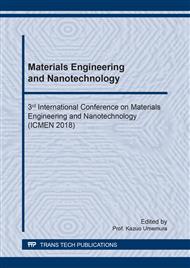p.82
p.88
p.93
p.98
p.105
p.110
p.116
p.121
p.126
Natural Antimicrobial Lignin in Polyvinyl Alcohol and Polyvinylpyrrolidone Film for Packaging Application
Abstract:
Lignin was extracted from sugarcane bagasse using alkali treatment process. The antimicrobial activity of sugarcane bagasse lignin (LNB) was evaluated against two pathogenic bacteria, Staphylococcus aureus and Escherichia coli by broth dilution method. The MIC and MBC values of LNB are 10,000 μg/ml and 20,000 μg/ml, respestively in both pathogenic bacteria. The composite film between polyvinyl alcohol (PVA) and polyvinylpyrrolidone (PVP) blending with LNB at five different amounts (1%, 3%, 5%, 10% and 15%) were produced by solvent casting. The chemical interactions of composite films were investigated using FTIR. The IR spectra indicates the formation of strong intermolecular hydrogen bonds between the hydroxyl groups of PVA or PVP and lignin. Furthermore, the overall migration was investigated. The migration results revealed that the PVA films blending with lignin up to 3% and the PVP films blending with lignin up to 5% could be considered suitable for application in fatty food packaging field.
Info:
Periodical:
Pages:
105-109
Citation:
Online since:
October 2018
Price:
Сopyright:
© 2018 Trans Tech Publications Ltd. All Rights Reserved
Share:
Citation:


